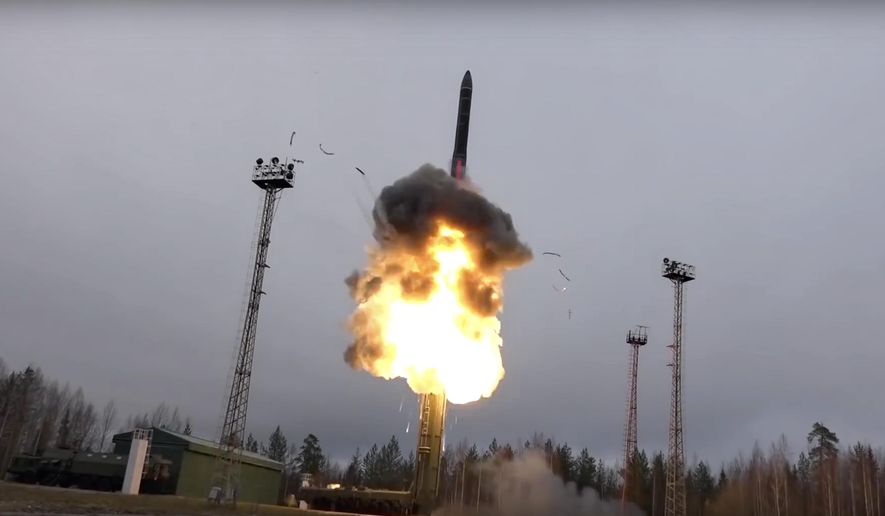OPINION:
Today, America’s freedom of strategic maneuver on the world stage is under growing threat. While the United States now possesses systems that provide protection against limited rogue-state ballistic missile threats (a product of the George W. Bush era), these capabilities fall far short of being a comprehensive shield against foreign aggression.
Meanwhile, a number of hostile nations are investing in a new class of weapons known as hypersonic missiles which are capable of defeating those deployed systems — and thereby potentially deterring America from defending its allies, interests and even the U.S. homeland itself.
Unlike ballistic missiles, which travel in a predictable arc, hypersonic missiles are extremely maneuverable. They are also extremely fast, narrowing the time available to defenders to respond. Finally, hypersonic missiles fly too low for long-range radar to detect them, requiring tracking from an elevated position. It’s no wonder that America’s adversaries — including Xi Jinping’s China and Vladimir Putin’s Russia — have come to view hypersonics as a strategic game-changer, and invested heavily in their development in recent years.
Even so, hypersonic missiles can be defeated. First, however, we have to see them coming – and the only affordable way to do so is from space. To defeat hypersonics, the United States needs a system of overhead sensors capable of providing global coverage.
For decades, America has dreamed of just such a global space-based surveillance system to track moving targets. But, while technically feasible, this venture has long been understood to be unaffordable. That, however, is now changing, as breakthroughs in low-cost space launch solutions and the mass manufacture of satellites increasingly put such a capability within reach.
Already three years ago, India set a world record when its official space agency launched 104 satellites into orbit on a single rocket. More recently, SpaceX, the private-sector space firm of billionaire entrepreneur Elon Musk, put 360 of its Starlink broadband satellites into orbit over the course of six launches in 2020.
The U.S. government is also making progress on this front. The Pentagon’s dedicated Missile Defense Agency (MDA) and its newer adjunct, the Space Development Agency (SDA), deserve kudos for taking the lead on developing a space sensor layer — an initial operational capacity for which is expected by 2022.
The system being developed by the Pentagon is far from perfect. But it doesn’t have to be. The effectiveness of a space sensor layer lies as much in deterrence as it does in tracking; to be strategically useful, the emerging system simply needs to undermine an adversary’s confidence that it can successfully execute a first strike against the United States.
But, if properly erected, a space sensor layer will do much more than just undermine an adversary nation’s ability to coerce us with hypersonic weapons. Such a sensor layer will provide astounding capabilities for tactical ISR (intelligence surveillance and reconnaissance): real-time tracking of nearly every kind of mobile target, enabling near-constant oversight of adversary forces, as well as better safety of navigation for global sea and air traffic.
Such a layer will be a boon for every combatant commend, creating a blanket of transparency to protect America’s homeland and U.S. allies in Europe, Asia and the Middle East. The benefits will be legion.
The United States today has the ability to field such a space layer, and do so rapidly. Such a transformational capability, in turn, would augment the operations of every branch of the American military, including the newly-created Space Force, where it would naturally be resident.
Making a space layer a reality, however, will require coordination — and consensus. The U.S. military’s newest branch is likely to balk at paying the bill for an initiative that augments the other services. This is not a new problem; for instance, airlift capabilities are the domain of the Air Force, but they exist to move equipment and people from the other services (Army, Marines, Navy).
To make sure the Air Force could operate this capability properly, Congress decades ago created a working capital fund that passed along costs to users, thereby freeing the Air Force from shouldering the financial burden of the service it provided.
Congress could do the same in the case of a space layer, and create a working capital fund for space development. Doing so would ensure that America can incubate the innovation it needs to confront the hypersonic threat — and to look beyond it.
• Peter Garretson is a senior fellow in defense studies with the American Foreign Policy Council (AFPC) and a strategy consultant who focuses on space and defense.




Please read our comment policy before commenting.